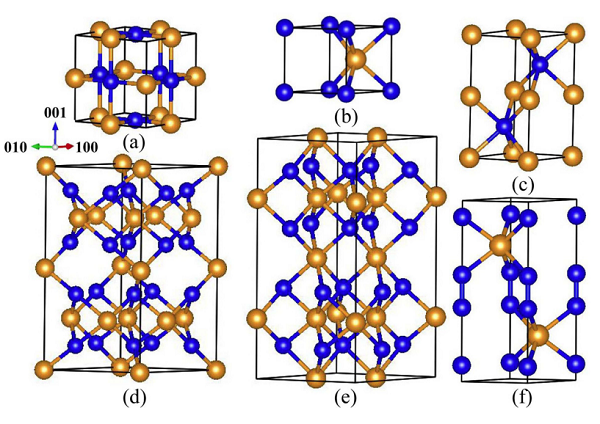Tungsten nitrides and W-N structures
May 10,2024
Description
Tungsten nitrides represent a distinct family of compounds with high melting temperatures and desirable mechanical properties. The electrical resistivity of tungsten nitrides is relatively low, and it has a low tendency to react with other metals compared with other transition-metal nitrides, indicating its suitability as a diffusion barrier. In addition, tungsten nitride (WN) is known as the original hydrodesulfurization (HDS) catalyst due to resistance to poisoning material and sintering at high temperatures [1].
Structure

Fig. 1. Crystal structures of six tungsten nitrides: (a) cP6-WN, (b) hP2-WN, (c) hP4-WN, (d) hP20-W2N3, (e) hP22-W5N6, and (f) hP6-WN2.
Considerable efforts were made early on to synthesize tungsten nitrides in various stoichiometries. Hägg first constructed the phase diagrams of W-N systems and reported the face-centered cubic β phase, which has a chemical composition of W2N. Kiessling and Liu observed the γ phase of the W-N system, formed at about 825 ◦C–875 ◦C when tungsten metal was nitrided with ammonia. The γ phase is closely related to the β phase with a distorted face-centered lattice. Schönberg later found the δ phase, which is isomorphous with WC, and confirmed the results of Hägg in all respects but could not verify the existence of the γ phase reported by Kiessling and Liu.
Recently, several additional tungsten nitrides, including hexagonal WN, hexagonal and rhombohedral W2N3, and cubic W3N4, were synthesized through[2]. Six viable W-N structures are identified, including one cubic structure (cP6-WN) and five different forms of hexagonal structures (hP2-WN, hP4-WN, hP6-WN2, hP20-W2N3, and hP22-W5N6), which were shown above. Some of these predicted structures have already been experimentally synthesized. Additional W-N structures, especially metastable ones, may not be included in this list.
References
[1] Jin, Haiyan et al. “A general synthetic approach for hexagonal phase tungsten nitride composites and their application in the hydrogen evolution reaction†.” Journal of Materials Chemistry A 23 (2018): 10967–10975.
[2] Cheng Lu, Changfeng Chen. “Indentation-strain stiffening in tungsten nitrides: Mechanisms and implications.” Physical Review Materials (2020).
- Related articles
- Related Qustion
Tris Hydrochloride is widely used in biochemistry for its versatile pH range and compatibility. Precautions include pH control and avoiding interference, despite limitations.....
May 10,2024APIMesityl Oxide, with its stable structure and low reactivity, can undergo substitution reactions and efficient absorption, allowing quantification via gas chromatography in pharmacokinetics.....
May 10,2024APITungsten nitride (wn)
12058-38-7You may like
- Malachite synthesis
Jul 31, 2024
- What are the uses and safety of Sodium sulfite?
Jul 31, 2024
- What is Zinc carbonate
Jul 30, 2024




